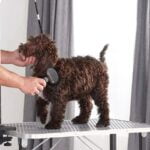Table of Contents
Teaching your dog to retrieve is not only a fun game but also a great way to provide mental and physical exercise. With patience and the right approach, your dog can learn to fetch and return items reliably. This guide offers essential tips on training a dog to retrieve, ensuring a successful and enjoyable experience for both you and your furry friend.

1. Choose the Right Toy
Selecting an appropriate toy is crucial for successful retrieve training:
- Size and Texture: Choose a toy that is easy for your dog to carry and is the right size for their mouth.
- Durability: Ensure the toy is durable and safe for your dog to chew on.
- Interest: Pick a toy that your dog shows interest in to keep them motivated.
2. Introduce the Toy
Start by familiarizing your dog with the toy in a positive way:
- Play Together: Engage in play with the toy to build your dog’s interest and excitement.
- Reward Curiosity: Reward your dog with treats and praise when they show interest in the toy.
- Positive Association: Create a positive association with the toy by making playtime enjoyable.
3. Teach the “Take It” Command
Encourage your dog to take the toy in their mouth on command:
- Hold the Toy: Hold the toy in front of your dog and say “take it.”
- Reward: When your dog takes the toy in their mouth, reward them with a treat and praise.
- Repeat: Practice this command several times until your dog reliably takes the toy on cue.
4. Teach the “Drop It” Command
Teaching your dog to release the toy is essential for a successful retrieve:
- Exchange for Treats: Offer a treat in exchange for the toy while saying “drop it.”
- Reward: When your dog releases the toy, give them the treat and praise.
- Practice: Repeat this process until your dog consistently drops the toy on command.
5. Start the Retrieve
Begin the retrieving process by combining the “take it” and “drop it” commands:
- Short Distances: Toss the toy a short distance and encourage your dog to fetch it.
- Use Commands: Say “take it” when your dog picks up the toy and “drop it” when they return.
- Reward and Praise: Reward your dog each time they successfully retrieve and return the toy.
6. Increase the Distance
Gradually increase the distance of the retrieve as your dog becomes more comfortable:
- Step by Step: Slowly increase the distance you throw the toy, ensuring your dog remains confident and successful.
- Stay Positive: Keep the training sessions positive and fun to maintain your dog’s enthusiasm.
- Consistency: Consistently use the commands and rewards to reinforce the behavior.
7. Add Variations and Challenges
Keep the retrieve game interesting by adding variations and challenges:
- Different Toys: Use different types of toys to keep the game exciting for your dog.
- Obstacles: Introduce obstacles or different terrains to challenge your dog’s retrieving skills.
- Multiple Toys: Teach your dog to fetch and return multiple toys in a single session.
Conclusion on Training a Dog to Retrieve
Successfully training a dog to retrieve involves choosing the right toy, introducing it positively, teaching the “take it” and “drop it” commands, starting the retrieve, gradually increasing the distance, and adding variations to keep the game interesting. By following these tips, you can help your dog develop reliable retrieving skills while ensuring they have fun. For more tips on dog training and care, visit the ASPCA and AKC.
FAQs on Training a Dog to Retrieve
How long does it take to train a dog to retrieve?
The time it takes varies depending on your dog’s age, breed, and personality. Consistent training and positive reinforcement typically yield results within a few weeks.
What if my dog doesn’t show interest in retrieving?
If your dog lacks interest, try using a different toy or adding excitement to the game. Ensure training sessions are fun and rewarding to maintain their enthusiasm.
Can all dogs be trained to retrieve?
Most dogs can be trained to retrieve with patience and consistent training. However, some breeds may be more naturally inclined to fetch than others.
How can I teach my dog to drop the toy?
Use treats and praise to encourage your dog to release the toy. Consistently practice the “drop it” command by offering a treat in exchange for the toy.
Is it okay to use different toys for retrieve training?
Yes, using different toys can keep the training interesting and engaging for your dog. Ensure each toy is safe and suitable for fetching.
Should I use a clicker for retrieve training?
A clicker can be a useful tool to mark the desired behavior. Click when your dog takes or drops the toy, followed by a treat and praise.











